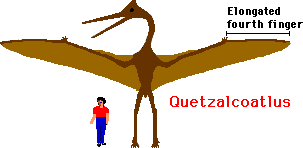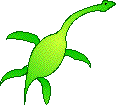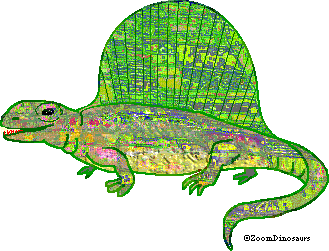 A: Quetzalcoatlus (a flying reptile, not a dinosaurs) lived during the late Cretaceous period and died out about 65 million years ago, during the K-T mass extinction. Click here for an information page on Quetzalcoatlus.
A: Quetzalcoatlus (a flying reptile, not a dinosaurs) lived during the late Cretaceous period and died out about 65 million years ago, during the K-T mass extinction. Click here for an information page on Quetzalcoatlus.
Q:1) What were Quetzalcoatlus' enemies?
2) How did it protect itself?
3) Where did it live?
from Matthew, Long Grove, Illinois, USA; Dec. 7, 1997
 A: Quetzalcoatlus (not a dinosaur) was a huge flying reptile (a pterosaur). It had a 40 foot (12 m) wingspread and was 8 feet (2.5 m) long! It lived during the late Cretaceous period. Its enemies were probably any large, agile carnivore that was capable of catching the giant flyer. It's hard to imagine a healthy, mature Quetzalcoatlus being caught, but the sick, old, and very young could be easy prey. Its best protection must have been flying, since it did not have armor, horns, or huge teeth; they only had small teeth and sharp claws on short fingers that protruded from their wings. Quetzalcoatlus fossils have been found in Texas, USA.
A: Quetzalcoatlus (not a dinosaur) was a huge flying reptile (a pterosaur). It had a 40 foot (12 m) wingspread and was 8 feet (2.5 m) long! It lived during the late Cretaceous period. Its enemies were probably any large, agile carnivore that was capable of catching the giant flyer. It's hard to imagine a healthy, mature Quetzalcoatlus being caught, but the sick, old, and very young could be easy prey. Its best protection must have been flying, since it did not have armor, horns, or huge teeth; they only had small teeth and sharp claws on short fingers that protruded from their wings. Quetzalcoatlus fossils have been found in Texas, USA.
Q: What is a Rhampherincus and how do you spell it correctly?
from Ted C., ?; March 10, 1998
A: Rhamphorhynchus was a small, flying reptile with a long tail and a long, toothed beak. It was not a dinosaur, but a pterosaur. Rhamphorhynchus lived during the late Jurassic in Europe
and Africa.
Q:Where there ever such things as Sabrecats?
from Andrew C., Sudbury, Ontario, CA; Feb. 15, 1998
A: Sabre-toothed cats are extinct carnivorous mammals. The were large, ferocious cats with huge fangs.
Smilodon, the sabre-toothed "tiger" from the late Pleistocene Epoch lived in packs, was up to 10 feet=3 m long, and had fangs up to 6 inches=15 cm long. It went extinct about 10,000 years ago.
Hoplophoneus is an earlier and smaller saber-toothed cat, from the Oligocene (20 million years earlier than Smilodon).
 Q:Are sharks dinosaurs or fish?
Q:Are sharks dinosaurs or fish?
from Alicia B., Batavia, NY, USA; Jan. 17, 1998
A: Fish.
Q: Question #1-What is the name of a dinosaur that lived in the water? Question #2-What is the name of a dinosaur with a big fin on its back? Question #3- Which dinosaur walked on two feet?
from Alyssa F., Whitehorse, Yukon, CA; November 29, 1997
 A: #1. No dinosaurs lived in the seas - they all lived on land!. Many aquatic animals (such as the Plesiosaur) lived in the seas, but these sea reptiles were NOT dinosaurs.
A: #1. No dinosaurs lived in the seas - they all lived on land!. Many aquatic animals (such as the Plesiosaur) lived in the seas, but these sea reptiles were NOT dinosaurs.
 #2. Spinosaurus and Ouranosaurus were sail-backed dinos. You might be thinking of the Dimetrodon, which was not a dinosaur.
#2. Spinosaurus and Ouranosaurus were sail-backed dinos. You might be thinking of the Dimetrodon, which was not a dinosaur.
 #3. A lot of dinosaurs walked on two feet, including the very early dinosaurs and many later models. Some well-known examples are: Tyrannosaurus, Unenlagia, Pachycephalosaurus, and many, many more.
#3. A lot of dinosaurs walked on two feet, including the very early dinosaurs and many later models. Some well-known examples are: Tyrannosaurus, Unenlagia, Pachycephalosaurus, and many, many more.
Q: I should like to find out: What was the largest dinosaur in the sea, and the information on it. Thanx !
from Sheridan L., manassas, va, USA; September 17, 1997
A: No dinosaurs lived in the seas - they all lived on land!
Q: I've read recently that some scientists believe that many ocean creatures, that have been believed to be extinct for millions of years, may be alive and well at the bottom of the ocean, what are your views on this thought?.......
from Matt R., Leicester, Leicestershire, United Kingdom; September 7, 1997
A: I think that there are lots of life forms that we've yet to discover, including some that were previously thought extinct. About fifty years ago, a living coelacanth was caught. This primitive, relatively large, lobe-finned fish was thought to have gone extinct millions of years ago and to exist only as a fossil. Finding it was quite a shock to the scientific community. If a large fish like this could remain undetected for so long, others species could also be undetected, especially those living in the extreme depths of the ocean.
Most of the ocean's depths are unexplored and many fascinating discoveries in cryptozoology will be made as robotic devices plumb the remote depths.
Return to the top of the page.
Enchanted Learning®
Over 35,000 Web Pages
Sample Pages for Prospective Subscribers, or click below
Click to read our Privacy Policy
Enchanted Learning Search
|
Search the Enchanted Learning website for:
|
Advertisement.
Advertisement.
Copyright ©1996-2018
EnchantedLearning.com ------ How to cite a web page


 #3. A lot of dinosaurs walked on two feet, including the very early dinosaurs and many later models. Some well-known examples are: Tyrannosaurus, Unenlagia, Pachycephalosaurus, and many, many more.
#3. A lot of dinosaurs walked on two feet, including the very early dinosaurs and many later models. Some well-known examples are: Tyrannosaurus, Unenlagia, Pachycephalosaurus, and many, many more.